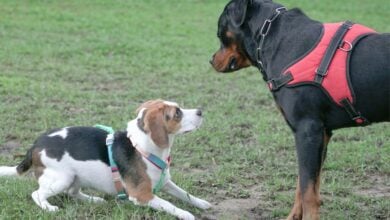Why Dogs Bark At Other Dogs (And How To Stop It)
When you purchase through links on our site, we may earn a commission. Here’s how it works.
You’re walking your dog when it happens: another pup appears, and suddenly your calm companion turns into a barking machine. Sound familiar? Embarrassing? Sure. But that noise isn’t naughtiness — it’s communication.
Table of Contents
Dogs don’t text or wave hello; they bark to talk. Some barks say “Let’s play!” Others shout “Back off!” or “Hey, look at me!”
Once you learn to tell them apart and curb the barking, every walk becomes less stressful and a lot more fascinating.

Why Do Dogs Bark At Other Dogs?
You’re certainly not alone if you’re always wondering,” why does my dog bark at other dogs?” When excessive, this behavior can ruin your calm walks and dog socialization attempts. I know the problem all too well from my past experience with my pup Tiny.
Barking is one of the main ways dogs communicate with the world around them. It’s perfectly natural for dogs to vocalize in different situations, from excitement to warning to plain old boredom.
When that barking happens toward other dogs, it’s usually rooted in one (or more) of the following emotional triggers.
1. Playfulness: “Hey, Friend — Come Join Me!”
Not every bark is aggressive. In many cases, your dog is simply trying to initiate play. You might notice a wagging tail, bouncy body language, or even a “play bow” — chest low, rear end up, tail wagging like a metronome.
These friendly barks are your dog’s way of saying, “You look fun. Let’s go!”
However, when a leash or fence is involved, even playful energy can sound intense. This is why leash reactivity often gets mistaken for aggression — the excitement gets bottled up and comes out louder than intended.
How to respond:
- Keep calm and use a cheerful tone — your dog takes emotional cues from you.
- Practice reward-based training by redirecting attention with a treat or cue like “Watch me.”
- Schedule controlled dog-to-dog greetings in neutral spaces to build positive associations.
2. Frustration: “I Want to Say Hi, But I Can’t!”
This is one of the most common reasons dogs bark at each other on walks. Your dog sees another pup, wants to run over and play, but the leash says no. That restriction leads to frustration barking — a mix of excitement and irritation.

Imagine seeing your best friend across the street, but someone won’t let you wave or say hi. That pent-up emotion comes out as a bark.
You’ll notice:
- Strained leash pulling
- Whining or high-pitched barking
- Rapid switching between excitement and agitation
Over time, repeated frustration can snowball into reactive behavior, where your dog barks automatically the moment they see another canine.
How to help:
- Give your dog more chances to socialize off-leash in safe, fenced environments.
- Teach “look at me” or “heel” cues to redirect focus.
- Use distance: step back until your dog can stay calm, then reward quiet behavior.
3. Attention-Seeking: “Look At Me, Not Them!”
Sometimes, barking at another dog isn’t about the dog at all — it’s about you. Your pup might have learned that barking makes you look their way, talk to them, or even hand out treats to quiet them down.
Over time, they figure out: bark = attention.
This can also happen in multi-dog households, where dogs compete for your focus.
Signs it’s attention-based:
- Your dog barks, then immediately looks at you.
- The barking stops as soon as you engage.
- It happens more often when you’re distracted.
What to do:
- Don’t reward the bark. Wait for a moment of silence before giving attention.
- Reinforce calm behavior with praise and treats.
- Add enrichment — puzzle toys, sniff walks, and training games — so your dog gets mental engagement elsewhere.
4. Fear or Anxiety: “That Dog Scares Me!”
Anxiety or fear-based barking is defensive, not defiant. Your dog might bark because another dog feels threatening, whether it’s due to size, posture, or even past trauma.

Shelter dogs or those who’ve had limited exposure to other pups often fall into this category.
You’ll notice:
- Ears pinned back, tail tucked, body leaning away
- Deep, repeated barks rather than playful yips
- Possibly growling or snapping when approached too quickly
These dogs aren’t trying to pick a fight — they’re asking for space. According to Certified Applied Animal Behaviorist Dr. Patricia McConnell, fear barking is a coping mechanism, not an act of dominance.
How to help:
- Avoid forcing interactions. Respect their comfort zone.
- Pair distant dog sightings with high-value treats to create positive associations.
- Consider professional guidance from a certified behaviorist or force-free trainer.
5. Territorial: “This Is My Turf!”
Dogs are naturally wired to protect their space and family. If another dog walks near their home, yard, or even favorite park spot, barking becomes their version of a “Keep Out” sign.
According to the American Society for the Prevention of Cruelty to Animals (ASPCA), your dog’s territory not only can include the area surrounding their home, but also, eventually, anywhere they’ve explored or associated with you.
Territorial barking is often accompanied by stiff posture, raised hackles, and persistent vocalization until the “threat” moves away. While it’s normal, it can become excessive without structure.
How to manage it:
- Block visual triggers with privacy film or strategic landscaping near fences or windows.
- Teach a “quiet” cue and reward compliance.
- Increase structured exercise — tired dogs bark less.

6. Undersocialization: “I Don’t Know What To Do Around Other Dogs.”
Dogs who weren’t properly socialized as puppies may react to other dogs with confusion, fear, or overexcitement. They simply don’t know the rules of canine etiquette.
According to the American Veterinary Society of Animal Behavior (AVSAB), the critical socialization window for puppies is between 3 and 14 weeks of age. Missing that stage can make future interactions unpredictable.
What to do:
- Start slow, structured exposure with calm, friendly dogs.
- Work at a comfortable distance before moving closer.
- Reward calm sniffing, glancing, and disengagement rather than barking.
Even older dogs can learn better manners — it just takes time, patience, and positive reinforcement.
Did You Know?
Most leash reactivity starts before age two, when dogs are still learning social boundaries. Early socialization can prevent lifelong barking habits.
Decoding The Types Of Barks
Not all barks sound the same, and once you learn the differences, you’ll understand your dog better than ever.

Here’s a quick cheat sheet:
| Type of Bark | Tone / Pitch | Meaning |
|---|---|---|
| Playful | Short, high-pitched bursts | “Let’s play!” |
| Frustrated | Rapid, repetitive yips | “I can’t reach them!” |
| Fearful | Deep, tense barks | “Back off — I’m scared!” |
| Territorial | Loud, consistent barks | “This is my space!” |
| Attention-seeking | Sharp, intermittent | “Hey, human, look at me!” |
What Is Reactive Barking?
You’ve probably seen it — a dog that loses their cool the moment another pup comes into view.
The lunging, barking, and pulling can look aggressive, but most of the time, it’s reactivity, not rage.
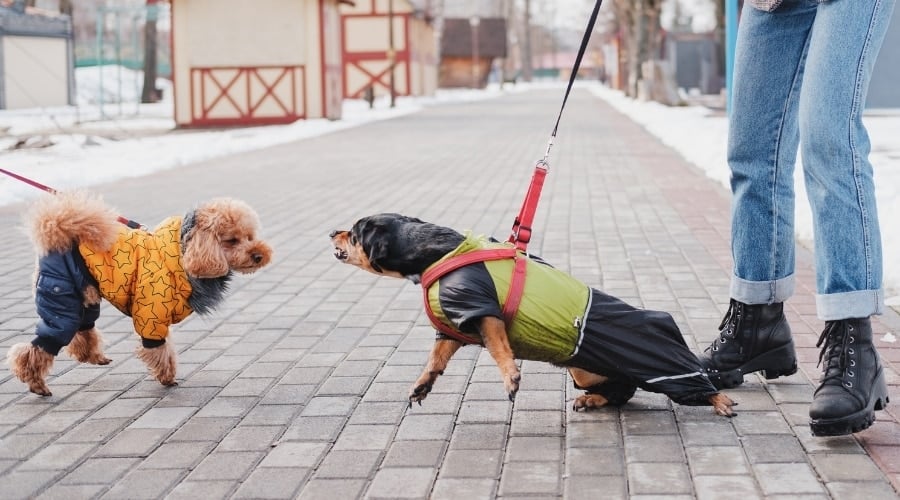
Reactive barking is an overreaction to a trigger, like seeing another dog, person, or even a skateboard. It’s an emotional outburst — think of it as a canine panic attack rather than bad manners.
Why It Happens
Reactivity usually comes from one of three roots:
- Fear – “That dog makes me nervous.”
- Frustration – “I want to greet them, but I can’t.”
- Overexcitement – “Dog! Dog! DOG!”
Over time, your dog’s brain builds a pattern:
Trigger → Bark → Adrenaline → Relief.
The behavior reinforces itself — they bark because it works.
According to veterinary behaviorist Dr. Karen Overall, reactivity is not dominance or disobedience. It’s a learned stress response that can be changed through training and confidence-building.
Red Flags Of Reactive Barking
- Barking and lunging the moment another dog appears
- Ignoring treats or cues when overstimulated
- Stiff posture, wide eyes, or tense tail
- Escalates quickly from excitement to agitation
If you see these signs, your dog’s barking comes from stress, not stubbornness.
How To Help A Reactive Dog
Managing reactivity is about reducing stress, controlling the environment, and reshaping emotional responses.
- Create Distance
The farther your dog is from their trigger, the more they can think clearly. Step off the path, cross the street, or duck behind a parked car until they can stay calm. - Reward Calm Behavior
Use high-value treats (chicken, cheese, or freeze-dried liver) to reward your dog for quiet observation. Calm = reward. Barking = nothing. - Don’t Punish Barking
Yelling or leash-jerking adds stress and confirms to your dog that other dogs are bad news. Stay neutral and redirect focus instead. - Teach a Focus Cue
Try “Watch me.” Every time your dog makes eye contact, treat. Over time, they’ll choose you over chaos. - Train Below Threshold
Expose your dog to triggers at a safe distance — close enough to notice, far enough to stay calm. This “counter-conditioning” process rewires their emotional response from panic to peace.
Real-Life Barking Frustrations
My colleague shared her experiences living with a reactive dog and what she’s doing to help.
My sweet old girl, Daisy, is almost 15 now, gray around the muzzle, slower on walks, and still absolutely convinced she runs the neighborhood watch. She’s always barked at other dogs, but lately it’s gotten so bad we only walk her late at night when no one’s around.
It’s not aggression, it’s more like she’s shouting, “I see you! Keep your distance!” But once she starts, my younger dog joins in, and suddenly it’s a full-blown duet echoing down the block. While I know she means no harm, it has made it awkward with the neighbors when she barks like a maniac at their tiny 5-pound Pom.
The truth is, senior dogs often get more reactive with age. Declining hearing, vision, or confidence, even mild cognitive decline, can make them anxious or quick to bark. For Daisy, it’s probably a mix of that and her lifelong “big feelings” toward other dogs.
Here’s what’s helping:
- Quiet routes + calm cues – picking low-traffic paths and keeping my tone relaxed.
- Treat training – rewarding her when she doesn’t bark.
It’s still a work in progress, but our walks are getting quieter now, not just because it’s midnight, but because Daisy’s learning she doesn’t have to bark at every tail she sees.
– Danielle DeGroot, Rescue Dog mom & Canine Journal Writer
How To Stop Your Dog From Barking At Other Dogs
Stopping your dog’s barking isn’t about “silencing” them — it’s about changing what the bark means. When your pup learns that calm behavior gets rewards and tension doesn’t, the barking naturally fades.

1. Stay Cool — Your Dog Feeds Off You
Dogs mirror human emotions. If you tense up or yank the leash, your dog’s stress spikes. Instead:
- Take a deep breath before reacting.
- Keep your voice calm and upbeat.
- Move away smoothly instead of dragging your dog.
Your calm energy signals that the situation isn’t dangerous.
2. Build Positive Associations
Your goal: teach your dog that seeing another dog = something good happens.
Try this:
- The moment your dog spots another dog, before barking starts, say “Yes!” and offer a treat.
- If they stay calm, reward again as the other dog passes.
- Over time, the sight of another pup predicts treats instead of tension.
This method, called counter-conditioning, is widely endorsed by modern trainers like Victoria Stilwell and is proven to reduce reactive responses over time.
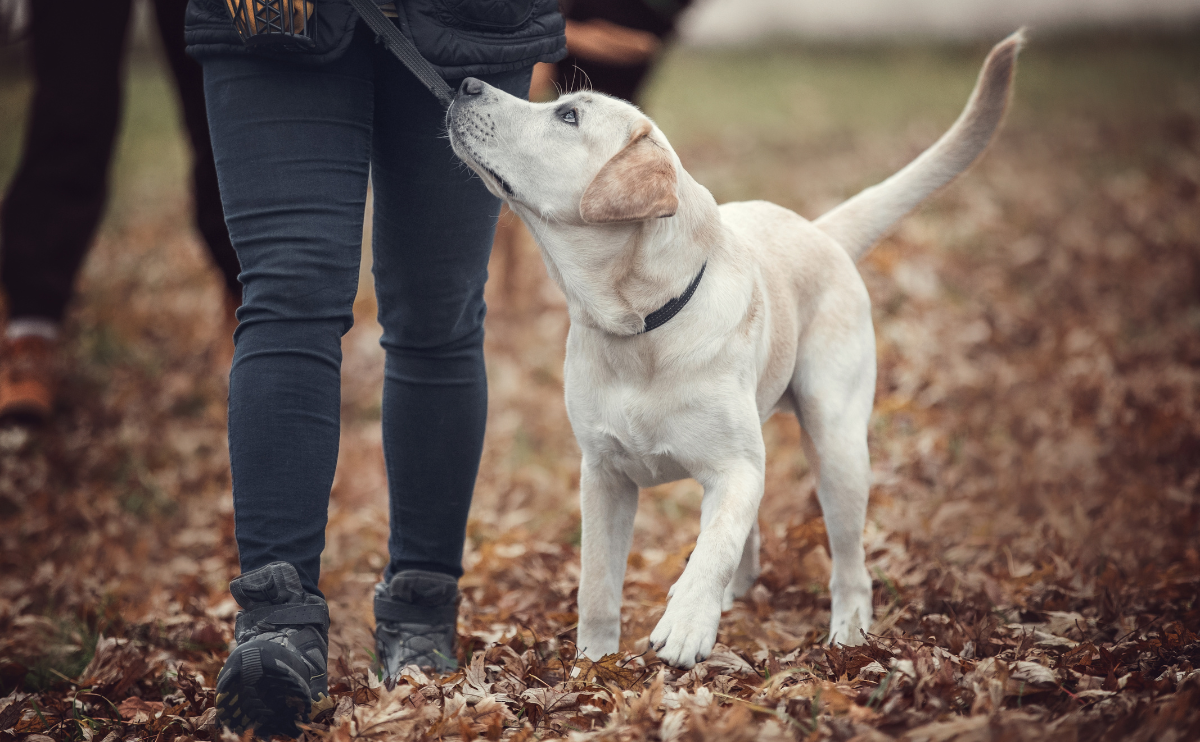
3. Practice “Look at That” Training
From Leslie McDevitt’s book Control Unleashed, this method flips the script:
- Your dog looks at another dog.
- You mark (“Yes!” or click).
- Your dog looks back at you for a treat.
It turns triggers into opportunities for focus — a game instead of a threat.
4. Increase Distance and Distraction
If your dog is already barking, they’re past the learning point. Move farther away until they can calm down. Then practice from that new “safe zone.”
Helpful distractions:
- Treat scatter (tossing treats on the ground to sniff out)
- “Find it” game to shift focus
- Gentle voice commands or tricks your dog already knows
5. Use Physical Aids Wisely
Sometimes tools make all the difference — as long as they’re gentle and supportive, not punitive.
Good options:
- Front-clip harnesses like Pet Safe Easy Walk or Ruffwear Front Range to reduce pulling
- Head halters (for experienced handlers) to help redirect attention
- Calming aids like pheromone calming collars or ThunderShirts for anxious dogs
Avoid choke, prong, or shock collars — they increase fear and worsen reactivity.
See our reviews of the best harnesses for dogs that pull.
6. Tire Out the Brain, Not Just the Body
A mentally satisfied dog is far less reactive. Add daily sniff walks, interactive toys, puzzle feeders, or training games to burn off excess energy in healthy ways.
According to research from the University of Bristol, mentally enriched dogs show fewer signs of stress and reactivity overall.
Quick enrichment ideas:
- Hide-and-seek with treats
- Frozen Kongs
- Nose work or “find it” scent games
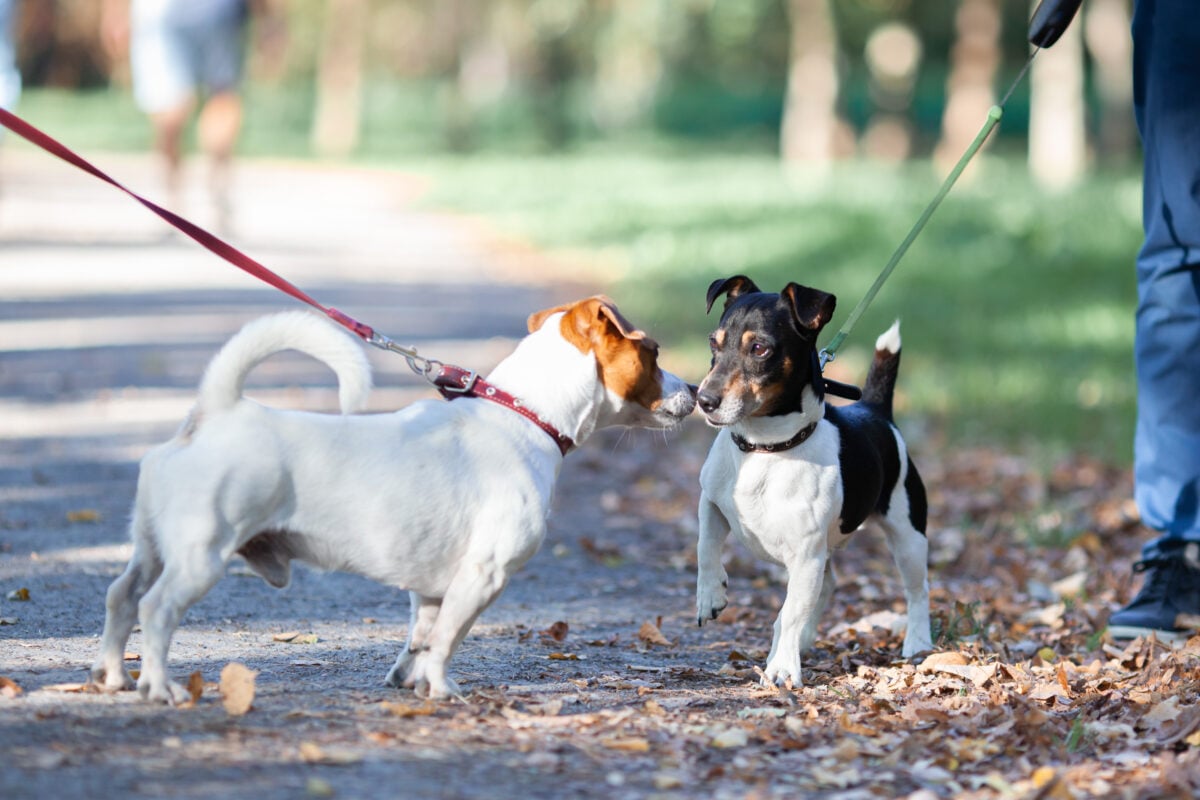
7. Keep Greetings Short & Sweet
Even friendly dogs can bark when greetings drag on too long. When meeting another dog:
- Ask permission before approaching.
- Allow a few seconds of sniffing, then call your dog away.
- End on a positive note before tension builds.
Short, structured interactions build confidence and prevent over-arousal.
8. Reward What You Want, Ignore What You Don’t
Dogs repeat behaviors that get results. If barking gets attention (even negative attention), it will continue. Instead:
- Reward calm behavior on walks (quiet glances, loose leash).
- Use a marker word like “Yes!” to signal success.
- Stay consistent — one exception can undo a week of progress.

9. Know When To Quit
If training sessions feel like a meltdown waiting to happen, end early. It’s better to have three calm minutes than twenty chaotic ones.
Reactivity takes time to fade, and patience pays off.
Need Extra Help With Training?
Online training programs can make a big difference if your dog’s barking feels out of control. See our expert reviews of the best online dog training courses, from personalized coaching to reactive-dog support, and find one that fits your pup’s needs.
When It’s Time For Professional Help
Sometimes, despite your best training efforts, your dog’s barking doesn’t get better — or even gets worse. That’s when it’s time to call in reinforcements.
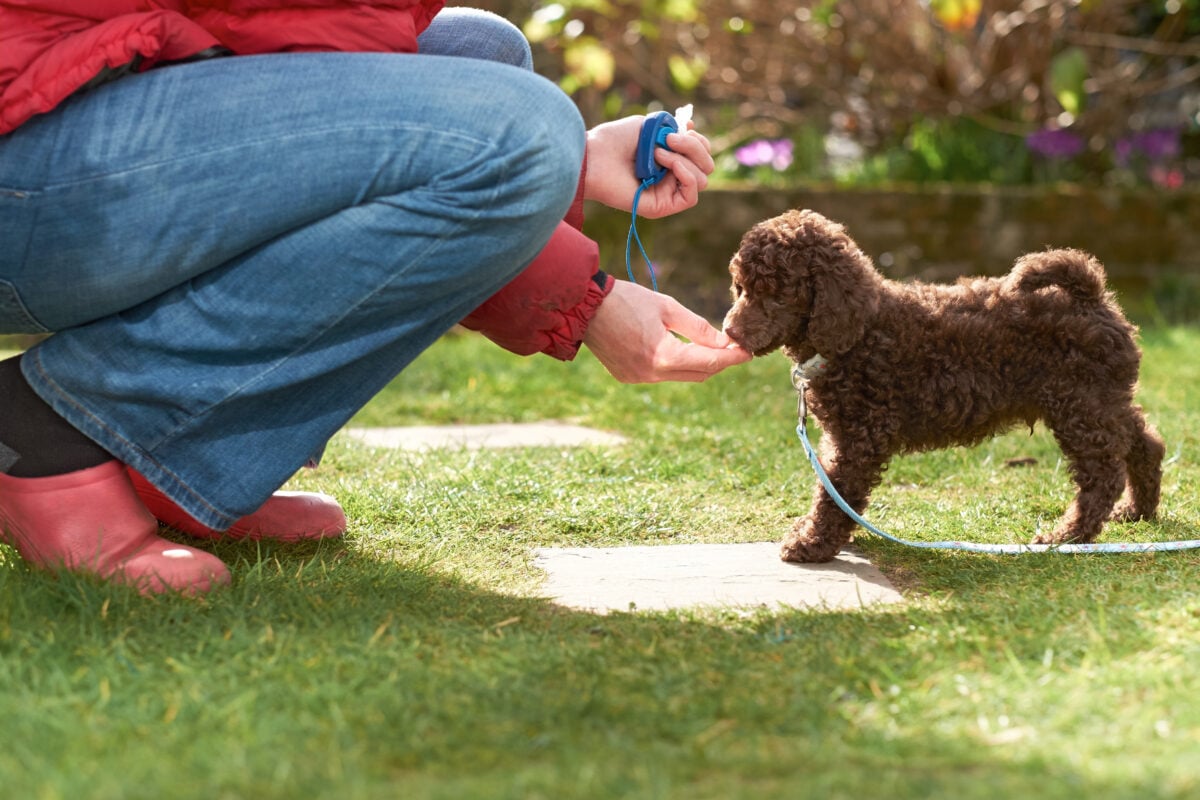
Reactivity and fear-based barking can stem from deep emotional roots that need an expert’s eye. A professional dog behaviorist can help identify triggers, adjust your training plan, and teach you handling skills to keep both you and your dog safe.
Signs You Need Extra Support
- Your dog barks, lunges, or growls even from long distances
- They’ve bitten or snapped at another dog
- You feel anxious or unsafe walking them
- Training progress has stalled after weeks of consistency
You’re not failing your dog by asking for help; you’re giving them the best chance to succeed.
Who To Turn To
- Certified Dog Trainer (CPDT-KA) — specializes in positive reinforcement and behavior shaping.
- Veterinary Behaviorist (DACVB) — a licensed vet who can assess anxiety, prescribe medications if necessary, and design a customized behavior plan.
- Fear-Free Certified Trainer — trained to reduce stress in anxious or reactive dogs.
You can find credentialed help through:
- Certification Council for Professional Dog Trainers (CCPDT)
- American College of Veterinary Behaviorists
- Fear Free Pets Directory
Many owners find that combining behavioral training with anti-anxiety medications or supplements can dramatically reduce reactivity. Talk to your vet before starting anything new.
Covering Behavioral & Other Veterinary Costs
Vet diagnostics, behavioral training consults, and behavioral treatments can add up. A good pet insurance plan can help cover unexpected costs for many different health and behavioral problems.
Explore our best pet insurance providers to see which plans fit your dog and budget. Keep in mind that securing a policy while your dog is still healthy and young is key because most insurers don’t cover pre-existing conditions.
Frequently Asked Questions
Wondering why your pup still barks at other dogs? You’re in good company! Check out these quick answers, and if your question’s not here, ask us in the comments below.
Why Does My Dog Bark At Some Dogs But Not Others?
Dogs are just like us — they have preferences. Your pup might react more strongly to certain breeds, sizes, or energy levels that remind them of a bad experience.
Some dogs are sensitive to eye contact or posture that feels “off.” Keep a mental note of which types set them off, which will help you manage future encounters.
Why Do Dogs Bark At Other Dogs Through Windows Or Fences?
That’s territorial barking, when your dog sees another dog entering what they consider their zone. Closing blinds, adding frosted window film, or using white-noise machines can cut down visual and auditory triggers. You can also teach a “quiet” cue by rewarding silence when the other dog passes.

Is It Normal For Puppies To Bark At Other Dogs?
Yes. Puppies are still learning canine manners! Early socialization is crucial, ideally between 3 and 14 weeks old. Introduce your puppy to calm, vaccinated dogs in controlled settings so they learn that other pups are friendly, not frightening.
Should I Let My Dog “Work It Out” With Another Dog?
No. Letting dogs “work it out” can quickly escalate to aggression. If barking starts, redirect and create distance. Controlled training setups rather than forced confrontations are the safest way to help your dog improve.
Can Bark Collars Help Stop This Behavior?
In mild cases, bark collars can be helpful; however, they don’t address the root cause (fear, frustration, or anxiety). If used improperly, they can also increase stress and worsen reactivity over time. Stick to positive-reinforcement training and consult a professional for sustainable results.
What’s The Difference Between Barking And Aggression?
Barking is communication. Aggression involves intent to harm. A barking dog might be scared or excited, while an aggressive dog shows stiff body language, growling, snarling, or snapping. If you’re unsure which applies to your dog, get a behavior assessment. It’s the safest way to know what’s really going on.
Understanding Dog Communication
Dogs have entire conversations without saying a word — a bark, a glance, a tail flick all mean something.
When we learn to read those cues, we stop guessing and start connecting. Learn more about the ways dogs communicate with each other and their body language when communicating with us.
Does your dog bark at other dogs on walks or at home? What finally worked for you? Drop your story in the comments — your experience might help another dog parent find peace on their next walk.




